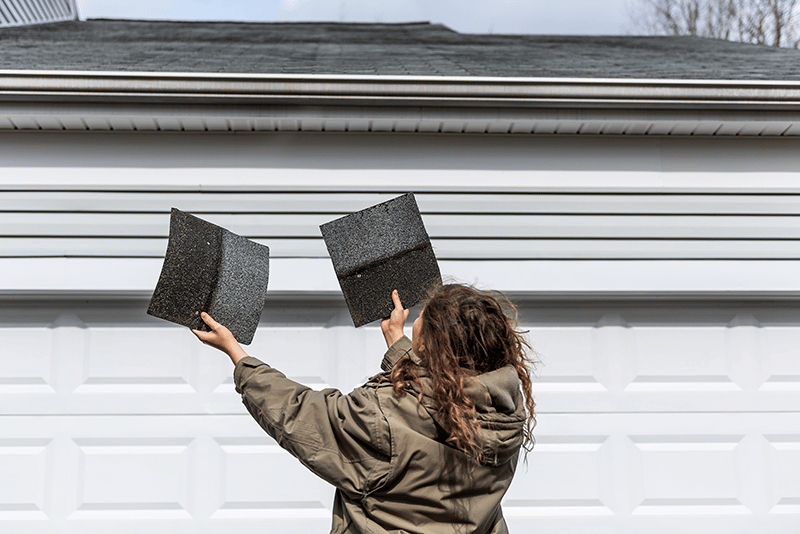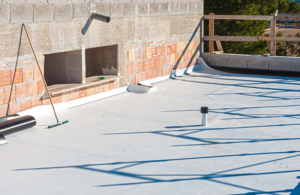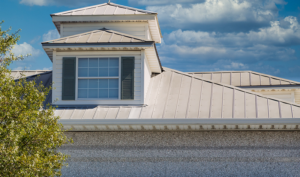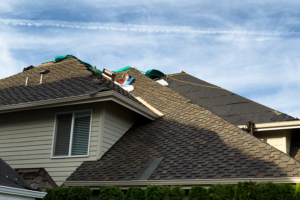Roof design affects the likelihood of wind damage because the varying strong force winds apply different forces to your roof. For example, houses with gables are more vulnerable than those with hip roofs. Like the corners and eaves, certain areas of the roof are at greater risk of being compromised. The materials and installation also affect the resilience of your roof.
Storms can bring hail damage, debris, or large tree branches resulting in structural damage, leaks, and subsequent water and wind damage. Over time, the sealant between shingles can fail, shingles can curl and crack, and repeated cycles of freezing and thawing can wear the shingles or rot the underlying structure, making it more vulnerable to wind damage, and ultimately to water damage. Roof repair for wind damage varies in cost for various roof types but often does not require a roof replacement since damage may be concentrated at the edges. A homeowner should check their insurance policy, and it will help with an insurance claim if there have been periodic roof inspections at various times during the lifetime of the roof.
Inspection
After the storm, walk your property, check your trees, look for shingles on the ground, and inspect your roof for missing shingles and other signs of roof issues, including the presence of tree limbs. High winds can ruin shingles without tearing them off entirely.
It would help if you also looked for other signs of aging, such as warping. If it looks like the corners of your roof are starting to curl up, or there’s a gap where the roof is separating from the fascia or soffit, your roof is damaged and at risk of further compromise from storms, freezing, and other severe weather. Finally, if you find signs of damage, then it is time to check your homeowners’ insurance policy and contact your insurance company.
What to Do When the Wind Damages Your Roof
You should visually inspect your roof after a severe storm. If you suspect damage, contact a licensed roofing contractor to evaluate your roof as soon as possible, and document any damage. We document wind damage to roofs with both a written description and photos to provide a detailed inventory of needed repairs along with a cost estimate.
As soon as you schedule the inspection, find out what your insurance covers. Homeowner’s insurance generally covers wind damage. However, it’s a good idea to look at your manufacturer warranty and contractor warranty as well. If your roof fails prematurely, warranties may be relevant to your claim for roof repair. If there has been an especially large storm, your roof may have incurred some severe wind damage.
How To Prepare
Wind mitigation involves adding features to your house and roof to diminish or prevent wind damage. During the building process, additional elements are integrated into the house’s structure to prevent roof damage, save money on potential repairs, and decrease your home insurance premiums.
Different Kinds of Wind Mitigation
There are a few different types of wind mitigation features that you can install in your home. Whether you are in the middle of the building process or want to make a new addition to your home, here are a few features to consider, including:
- Roof Material: If you are currently building your home or getting a replacement roof, consider choosing a more durable material that can withstand stronger winds. Select a component that has a 110-mph wind resistance, is UL 2218 for impact resistance, and meets ASTM D3161 Class F standards.
- Roof-to-Wall Attachments: To give your roof truss the most significant amount of protection from wind uplift, consider including roof-to-wall attachments. Select a double metal connector wrap with three or more nails on each side.
- Roof Deck Material: This feature can only be added if you are building your roof for the first time or are installing a replacement. Ask your builder to secure the perimeter of the roof using 5/8-inch plywood panels fastened with 10-d nails.
- Opening Protection: Place hurricane coverings over the windows and doors. These coverings decrease the risk of internal pressurization and prevent damage to the home.
- Secondary Water Barrier: For even more protection against water and wind damage, consider installing a secondary water barrier. The barrier should be either a foam adhesive SWR or self-adhering membrane attached to the roof decking to prevent water from entering your home during a storm.
- Gable End Bracing: Do you have a gable roof? Checking the bracing may be part of your roof inspection.
Wind Resistant Roofing Materials
Though tiles are heavier than shingles, their true advantage in wind resistance is their shape and construction, allowing wind freer travel, reducing stress. Tile roofs, when properly installed, can handle wind speeds exceeding 150 mph or greater. Metal roofs are also more resistant to wind shear when the leading edges are correctly secured. Shingle roofs tend to have the most problems withstanding high winds, but thicker, longer-lasting shingles hold up better and are worth the additional cost.
RESOURCES
Blue Nail Roofing has a Master Elite contractor status awarded by the largest roofing manufacturer in North America, GAF. Only 2% of contractors in the US meet the rigorous standards to achieve this status, which means you can be assured you are making a good choice when selecting the professionals at Blue Nail to execute your home and business roofing repairs. Call today to schedule a professional evaluation!
Copyright © 2020 Blue Nail Enterprises. All rights reserved. | Privacy Policy
Let Us Nail Your Project!
Please send us a little information about your roofing or home improvement needs, and an expert will reach out shortly.







